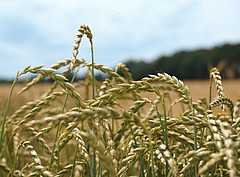Ancient grain & baking quality:
Largest spelt test to date reveals major differences in quality [03.05.17]
First-class spelt could be further improved through breeding: Researchers at the University of Hohenheim have developed simple, rapid tests for the grain industry
High yield, resistance to lodging and disease: These were the priority criteria in the cultivation and breeding of spelt up to now. However, according to the results of the largest spelt test ever with some 160 spelt varieties, this prioritization disregards the requirements of bakers. The evaluation of this trial is now presented by the University of Hohenheim in Stuttgart. Up to now, these criteria have led to varieties with poor baking quality keeping their foothold on the market. But the results also showed that new breeds were possible that combined first-class cultivation and baking traits. As part of the spelt trial, the researchers also developed several rapid tests that millers, bakers and pasta producers can use to assess baking quality already when purchasing spelt.
German farmers can choose between 150 different wheat varieties for sowing each year, but just under a tenth as many spelt varieties are available. However, despite the small number, the baking traits of these varieties varied considerably.
"That makes sense," said grain researcher PD Dr. Friedrich Longin from the State Plant Breeding Institute at the University of Hohenheim: "With spelt, there are just as big quality differences as there are with wheat – but people have scarcely paid any attention to them up to now. So there's still a lot of potential to be tapped."
He therefore tested 160 spelt varieties in a large-scale trial: ranging from the traditional Oberkulmer Rotkorn to the modern Zollernspelz variety. A total of 600 different samples of the spelt varieties were cultivated at three different locations in Baden-Württemberg. They were then sent for testing to the baking laboratory – with very varied results.
Baking traits ranged from very good to very poor
The most striking result: Spelt traits differed markedly as far as baking quality was concerned: "The baking traits ranged from very poor to very good – for both old traditional varieties and modern varieties," said Dr. Longin when summarizing the trial results.
Until now, the only knowledge available on most spelt varieties had to do with yield and disease resistance. But thanks to the trial results, information was now available on the baking qualities of the individual varieties, too. In this way, the positive baking traits could be combined in a targeted manner with the positive cultivation traits – for improved baking traits with consistently high yield and a reduced cultivation risk. Here, Dr. Longin hoped to secure the support of breeders.
Baking traits should be tested during variety approval
The grain expert suspected that the reason why some spelt varieties were still cultivated despite their poor baking traits had to do with the production chain: It started with the farmer, who has traits in mind when selecting which variety to cultivate that differed from those of millers and bakers.
Dr. Longin, on the other hand, found: "It is the actual baking traits of the varieties that need to be evaluated earlier on. Varieties that perform extremely poorly here should not even be placed on the market in the first place."
Ideally, these baking traits should be tested together with the cultivation traits during variety approval by the Federal Plant Variety Office (BSA). If the variety was approved, then this should be reported to the entire market. "In this way, the industry as a whole would know which varieties are suitable for which types of products, without each link in the production chain having to acquire this knowledge itself and at great expense," said Dr. Longin.
Comprehensive results and easy-to-use tests
With two approaches, the trial aimed to help provide breeders and farmers, as well as millers and bakers, with more information about baking traits. First, there were the trial results for the 160 spelt varieties. "For the first time, we have comprehensive results on yield, lodging resistance, health, and baking traits for a large number of varieties," said Dr. Longin when emphasizing the importance of the trial.
Second, some of the tests used in the trial permitted the analysis of quality and baking traits at every point along the production chain. "Our trial is based on a series of tests. Some of them already say a lot about the baking quality of a variety and require little effort. I really would advise every breeder, miller and baker to use these tests themselves."
There were two tests in particular that he wanted everyone in the production chain to perform: First, a so-called extensograph that tests dough extensibility mechanically. However, a slightly more rapid method to examine protein quality on the basis of sedimentation volume that already works with just a few grams of flour, would also be sufficient.
Largest spelt trial ever at three locations
It took just under two years to cultivate and harvest the 160 spelt varieties and then dispatch 600 samples for testing to a baking laboratory. The University of Hohenheim injected € 100,000 into this project from spelt breeding royalties. The companies Südwestsaat Rastatt and Pflanzenzüchtung Oberlimburg backed the project and planted the varieties on their plots of land.
This meant that samples from plots in Rastatt, Schwäbisch Hall and from the experimental plots of the University of Hohenheim on Ihinger Hof in the district of Böblingen could be examined. This revealed differences between the samples from the different locations, but Dr. Longin said: "A variety with good baking traits at one location is not significantly worse in this respect at another location either."
Spelt baking tests: Results
Text: Barsch / Klebs
Contact for press:
PD Dr. Friedrich Longin, Universität Hohenheim, Leiter Weizenzüchtung und -forschung der Landessaatzuchtanstalt Hohenheim
T 0711 459-23846, E friedrich.longin@uni-hohenheim.de


